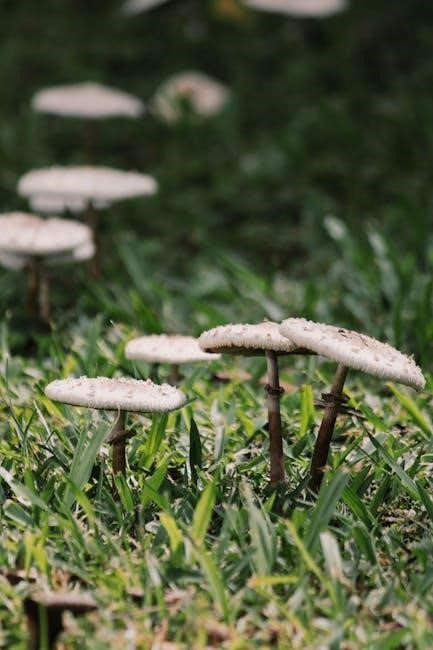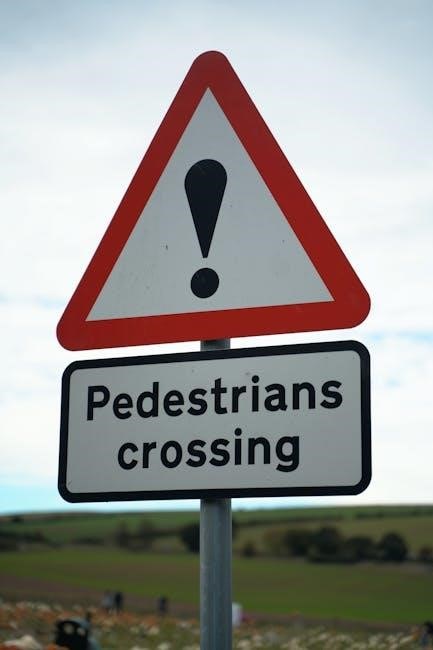field guide mushrooms
Field guide mushrooms provide essential information for enthusiasts, including
- lists
of species and
characteristics
to aid in accurate identification and exploration of various mushroom types and families always using multiple sources․
- keys

Importance of Accurate Identification
Accurate identification of mushrooms is crucial for several reasons, including safety and conservation․ Many species of mushrooms can be toxic or even poisonous, and incorrect identification can lead to serious health issues․ According to various sources, the importance of accurate identification cannot be overstated, as it can mean the difference between life and death․
Mushroom enthusiasts and experts alike rely on field guides to provide them with the necessary information to accurately identify species․ The use of comprehensive field guides, such as the National Audubon Society Field Guide, can help to ensure that identifications are accurate and reliable․ By using these guides, individuals can learn to recognize the characteristics of different species and make informed decisions about which mushrooms are safe to handle or consume․ This is especially important for beginners, who may not have the necessary experience or knowledge to accurately identify mushrooms on their own․
Methods of Identification
There are several methods of identification used in field guide mushrooms, including observation of physical characteristics, such as shape, size, and color․
Experts also use microscopic examination of spores and other features to aid in identification․ Additionally, the use of keys, which are lists of characteristics that help to narrow down the possible identity of a mushroom, is a common method․
Some field guides also include information on the habitat and distribution of different species, which can be helpful in making an identification․ By using a combination of these methods, mushroom enthusiasts can increase their chances of making an accurate identification․
The internet also provides a wealth of information on mushroom identification, including online forums and databases, where individuals can share their findings and get feedback from other experts․ This can be a valuable resource for those looking to learn more about field guide mushrooms․

Recommended Field Guides
National Audubon Society Field Guide is highly recommended for mushroom identification with
- lists
of species always․
National Audubon Society Field Guide
The National Audubon Society Field Guide to North American Mushrooms is a comprehensive guide, featuring detailed descriptions and stunning color photographs of various mushroom species․ This field guide is considered a must-have for mushroom enthusiasts, providing essential information for accurate identification․ The guide includes a wide range of species, from common to rare, and offers tips for distinguishing between similar-looking mushrooms․ With its extensive coverage and user-friendly format, the National Audubon Society Field Guide is an invaluable resource for anyone interested in learning about mushrooms․ The guide’s author, Gary Lincoff, is a renowned expert in the field of mycology, and his expertise shines through in the guide’s detailed and accurate descriptions․ Overall, the National Audubon Society Field Guide is an excellent choice for anyone looking to learn about and identify mushrooms in North America, with its combination of detailed information and beautiful photographs making it a joy to use․
Other Notable Field Guides
Several other field guides are also highly recommended for mushroom enthusiasts, including the Mushrooms of Northeastern North America guide and the Field Guide to Wild Mushrooms of Pennsylvania and the Mid-Atlantic․ These guides provide detailed information on the various species found in these regions, including their habitats, characteristics, and distinguishing features․ The guides are written by experienced mycologists and feature high-quality photographs and illustrations to aid in identification․ Some guides, such as the Audubon Mushrooms mobile app, also offer advanced search functions and extensive descriptions to help users identify mushrooms․ Additionally, guides like the Keystone Field Guide series offer comprehensive coverage of specific regions, making them invaluable resources for local mushroom enthusiasts․ Overall, these field guides are excellent resources for anyone looking to learn about and identify mushrooms, and can be used in conjunction with other guides to build a comprehensive understanding of the subject․ They are useful tools for both beginners and experienced mushroom enthusiasts․

Features of a Good Field Guide
A good field guide has
- clear
and
- concise
information always using multiple sources and formats․
Comprehensive Color Pictures
Comprehensive color pictures are a crucial feature of a good field guide, allowing users to visually identify mushrooms and other fungi․ The National Audubon Society Field Guide to North American Mushrooms is a great example, with its extensive collection of high-quality images․ These pictures should be clear and well-lit, showcasing the various characteristics of each species, such as cap shape, gill attachment, and stem color․ A good field guide will also include pictures of the mushrooms in different stages of growth and development, as well as any distinctive features, like veins or pores․ By including comprehensive color pictures, field guides can help enthusiasts and experts alike to accurately identify and learn about the various species of mushrooms․ This feature is especially important for beginners, who may not have the necessary experience or knowledge to identify mushrooms based solely on written descriptions․ Overall, comprehensive color pictures are an essential component of a good field guide․
Extensive Descriptions
Extensive descriptions are a vital component of a good field guide, providing users with detailed information about each mushroom species․ These descriptions should include details about the mushroom’s habitat, distribution, and growth patterns, as well as its physical characteristics, such as size, shape, and color․ A good field guide will also include information about the mushroom’s edibility, toxicity, and any lookalike species․ The descriptions should be written in a clear and concise manner, making it easy for users to understand and identify the different species․ By including extensive descriptions, field guides can help enthusiasts and experts alike to gain a deeper understanding of the various species of mushrooms and their unique characteristics․ The use of
- ordered lists
and
- unordered lists
can also help to organize and present the information in a logical and easy-to-follow manner, making it easier for users to learn and identify mushrooms․ This feature is essential for anyone interested in mycology․

Using Multiple Field Guides
Using multiple field guides helps ensure accurate identification of mushroom species using
- various
sources and methods always․
Importance of Verification
Verification is a crucial step in mushroom identification, as it helps to confirm the accuracy of the identification․ Using multiple field guides and consulting with experts can help to verify the identity of a mushroom species․ This is especially important for beginners, as it can help to prevent misidentification and ensure that the correct species is identified․ The process of verification involves comparing the characteristics of the mushroom with those described in the field guides and consulting with experts to confirm the identification․ By verifying the identity of a mushroom species, enthusiasts can gain a deeper understanding of the species and its characteristics, and can also help to improve their skills in mushroom identification․ Verification is an ongoing process that requires continuous learning and consultation with experts, and is essential for accurate and reliable mushroom identification, using various methods and
- techniques
always․
Avoiding Pictures for Initial Identification
When identifying mushrooms, it is recommended to avoid using pictures for initial identification․ This is because pictures can be misleading and may not accurately represent the characteristics of the mushroom․ Instead, enthusiasts should focus on using descriptive texts and
- keys
to identify the species․ Pictures can be used as a final step to confirm the identification, but should not be relied upon as the primary means of identification․ By avoiding pictures for initial identification, enthusiasts can develop a more nuanced understanding of the characteristics of different mushroom species and improve their skills in identification․ This approach also helps to reduce the risk of misidentification, which can have serious consequences․ Using a combination of descriptive texts and
- techniques
can help to ensure accurate identification and a deeper understanding of the species, and is an important part of the identification process, always using multiple sources․
